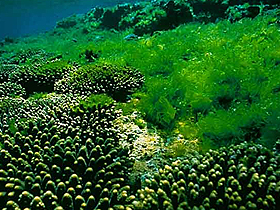 Algae are photosynthesizing organisms that live everywhere: in both fresh and salt water, desert sand, underground hot springs, and even under snow and ice. They vary in shape and size, from single-celled organisms to kelp up to 60 meters (196.85 feet) long. . By their photosynthesizing, they break down CO2 and release a large amount of the oxygen into the atmosphere.
Algae are photosynthesizing organisms that live everywhere: in both fresh and salt water, desert sand, underground hot springs, and even under snow and ice. They vary in shape and size, from single-celled organisms to kelp up to 60 meters (196.85 feet) long. . By their photosynthesizing, they break down CO2 and release a large amount of the oxygen into the atmosphere.
The origins of algae go back to very early times. Fossilized algae have been found that date from 3.1 to 3.4 billion years ago. How algae came to be is one of those questions that have left evolutionists at an impasse. They claim that the first cell evolved over time to form algae and for this reason, the algae are a primitive form of plant.
But two factors show this explanation to be false: First, the theory of evolution has still been unable to explain how the first plant cell came into being. And, second, algae do not have the primitive structure one would expect. On the contrary, they are complex organisms whose living examples are indifferent from the earliest fossils known.
Both blue-green algae and bacteria fossils dating back 3.4 billion years have been found in rocks from S. Africa. Even more intriguing, the pleurocapsalean algae turned out to be almost identical to modern pleuroca psalean algae at the family and possibly even at the generic level.6
psalean algae at the family and possibly even at the generic level.6
The German scientist, Professor Hoimar Von Ditfurth, makes the following comment on the structure of so-called “primitive” algae:
The oldest fossils so far discovered are objects fossilized in minerals which belong to blue-green algae, more than 3 billion years old. No matter how primitive they are, they still represent rather complicated and expertly organized forms of life.7
When we examine the structures that algae use to form their cell walls, we see that these organisms are by no means basic and primitive. The organic polyamine they use to produce their tissues is a complex chemical material, and to build their cell walls, algae use the longest polyamine chain found in nature.
As the algae go through the process of photosynthesis together with complex chlorophyll, they also produce a yellowish-gold colored pigment called xanthophylls. These single-celled organisms are fishes’ major source of Vitamin D and have a complex structure designed for a special purpose.8
Just as evolutionists have been unable to account for the origins of the first cells, so they cannot explain how these first plant cells gave rise to the first algae cells, whose complex structure is no different from algae living today.
6 “Ancient Alga Fossil Most Complex Yet”, Science News, Vol. 108, 20 September 1975, p. 181.
7 Hoimar Von Ditfurth, The Silent Night of the Dinosaurs, Istanbul: Alan Publishing, November 1996, Trans: Veysel Atayman, p.199.
8 N. Kroger, R. Deutzmann, M. Sumper, “Polycationic Peptides from Diatom Biosilica That Direct Silica Nanosphere Formation”, Science, 286, pp. 1129, 1999.


